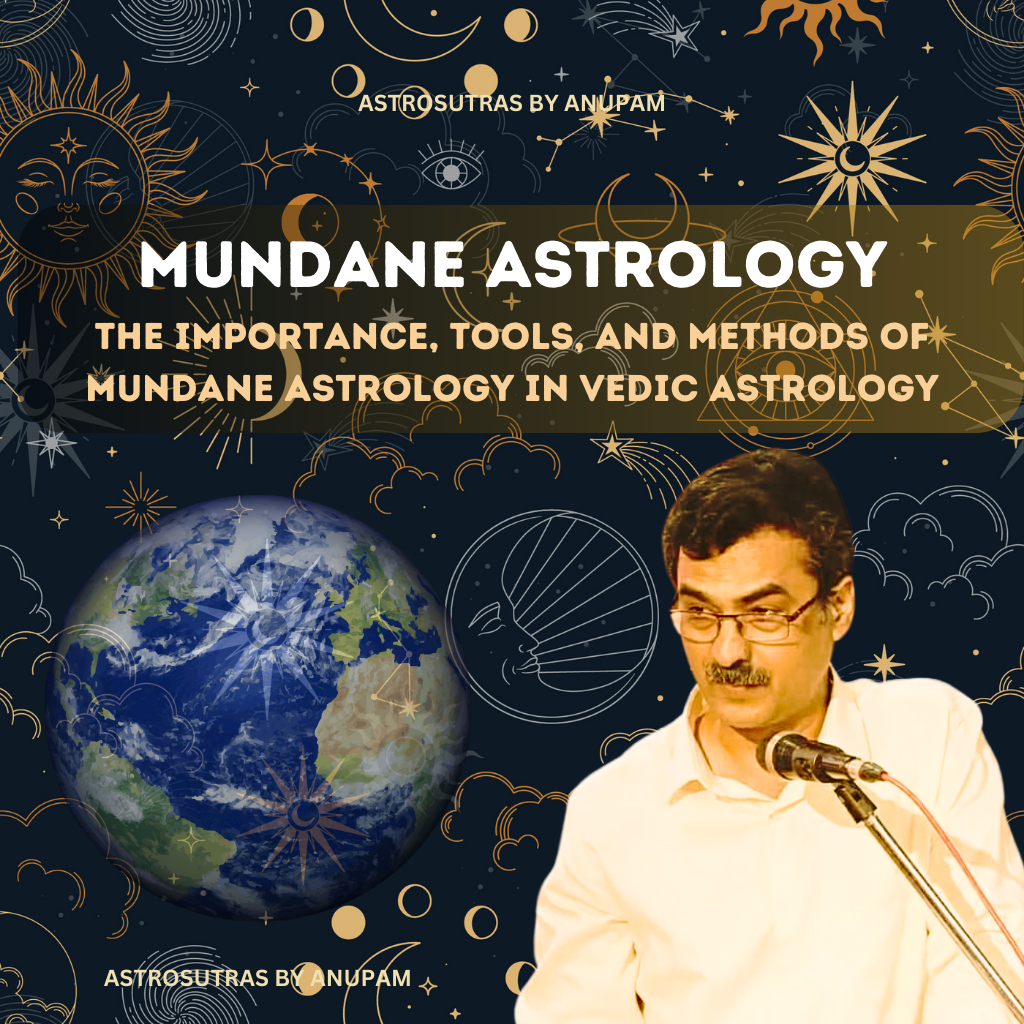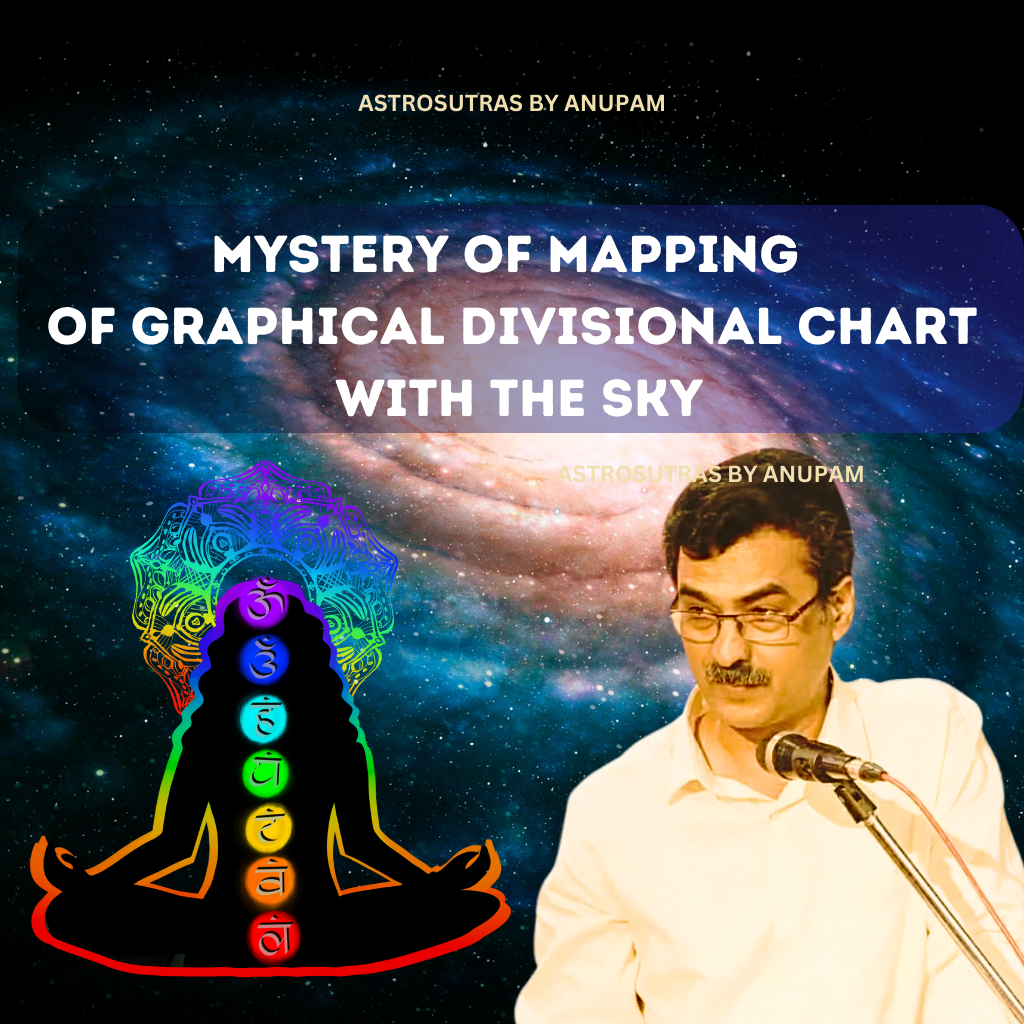The Importance, Tools, and Methods of Mundane Astrology in Vedic Astrology

Introduction
Mundane astrology, known as “Medini Jyotish” in Vedic astrology, is a branch of astrology that deals with the prediction and analysis of world events, including natural disasters, political affairs, economic fluctuations, and social transformations. Unlike natal astrology, which focuses on individuals, mundane astrology studies celestial influences on nations, societies, and global phenomena. By examining planetary positions, transits, and alignments, astrologers can predict and analyze large-scale occurrences that shape the course of human history. This essay delves into the significance of mundane astrology, its essential tools, and the systematic methodologies employed in Vedic astrology to interpret and predict macrocosmic events.
Importance of Mundane Astrology
1. Understanding Cosmic Influences on Human Civilization
Mundane astrology helps in understanding the larger cosmic forces affecting humanity. By analyzing planetary positions and transits, astrologers can foresee significant global events such as wars, pandemics, and economic booms or recessions. The interaction between planetary cycles and global events suggests that celestial mechanics influence human history, economic cycles, and social movements. This insight allows governments and institutions to be better prepared for impending changes.
2. Political Forecasting
Governments and policymakers often seek astrological guidance to understand potential crises or prosperous periods. Historical records indicate that many rulers and statesmen consulted astrologers for strategic decision-making. For example, in ancient India, kings would base their military campaigns, coronations, and administrative policies on astrological predictions. Modern political analysts have observed that planetary transits affecting the charts of nations often correlate with political upheavals, elections, and leadership changes.
3. Economic Predictions
Mundane astrology plays a crucial role in predicting economic trends. The planetary configurations at the time of a nation’s birth chart, coupled with major transits and dashas (planetary periods), can indicate periods of financial growth or economic downturns. The influence of Saturn and Jupiter in economic cycles is well-documented, with Jupiter indicating expansion and Saturn representing contraction. The conjunctions and oppositions of these planets can signal financial crises or periods of economic prosperity.
4. Natural Disasters and Climate Change
Astrologers analyze eclipses, planetary alignments, and lunar mansions (Nakshatras) to predict earthquakes, tsunamis, cyclones, and other natural calamities. This information can help authorities in planning disaster preparedness and mitigation efforts. Historical analysis shows a strong correlation between major celestial events and natural disasters. The impact of planetary movements on earth’s tectonic activities, climatic shifts, and atmospheric phenomena continues to be a subject of study in mundane astrology.
5. Social and Cultural Trends
Cultural revolutions, ideological shifts, and technological advancements can also be studied through mundane astrology. The movement of Jupiter (Guru) and Saturn (Shani) often influences philosophical, religious, and social transformations. For example, the Saturn-Jupiter conjunctions in different elements (fire, earth, air, and water) indicate long-term trends in education, governance, technological progress, and social attitudes. These planetary cycles provide insight into shifts in human consciousness and societal structures.
Tools of Mundane Astrology
1. National and Inception Charts
Each country has a horoscope based on its independence or foundational moment. This chart serves as the baseline for predictions regarding the country’s future. The planetary placements at the time of a nation’s birth determine its strengths, challenges, and potential turning points.
2. Planetary Transits
The movement of planets over time provides critical insights into global affairs. The transits of major planets like Jupiter, Saturn, Rahu, and Ketu have long-term impacts on world events. The slow-moving planets, especially Saturn and Pluto, are often associated with global crises, restructuring, and long-lasting changes.
3. Eclipses
Eclipses are significant celestial events that often indicate disruptions in governance, geopolitical tensions, and climatic changes. Lunar and solar eclipses occurring near significant planetary conjunctions can foretell political assassinations, financial downturns, and regional conflicts.
4. Dashas and Mahadashas
The Vimshottari Dasha system is applied to national charts to assess time periods of prosperity, challenges, and conflicts. Each planetary period affects the socio-political and economic landscape of a nation, depending on the position of the ruling planet in the national chart.
5. Astrological Yogas
Certain planetary combinations (yogas) in mundane astrology, such as Raj Yoga and Kal Sarpa Yoga, can signal periods of prosperity or crisis for a nation. The presence of malefic yogas can indicate instability, while benefic yogas can bring progress and expansion.
6. Ashtakavarga System
This system is used to assess the strength of planets in a mundane chart, helping in predictive accuracy. The Ashtakavarga score of a nation’s horoscope provides insights into the effectiveness of governance, economic stability, and the overall direction of growth.
7. Panchanga (Hindu Almanac)
Mundane astrologers use Panchanga to determine auspicious and inauspicious periods for major national and global events. The Tithis (lunar days), Nakshatras, and planetary hours play a crucial role in deciding favorable periods for governance and decision-making.
Methods of Mundane Astrology
1. Analyzing the National Horoscope
Each country’s horoscope is studied by analyzing planetary placements, dashas, and transits. This helps in identifying trends in governance, economy, and public welfare.
2. Studying the New Year Chart (Varshaphala)
The Hindu New Year chart, based on Chaitra Shukla Pratipada, is cast annually to predict the forthcoming year’s events. This technique provides insights into the major occurrences in a country or region for that specific year.
3. Electional Astrology (Muhurta)
This technique helps in selecting auspicious dates for political events, policy decisions, and national movements. Electional astrology ensures that decisions are made at a time when planetary influences are favorable.
4. Mundane Transit Analysis
By observing the transits of major planets, astrologers predict global events, including economic trends and political shifts. The return of certain planets to their original positions in national charts often signals significant changes.
5. Astrocartography
This method maps planetary influences on different geographical locations, helping in understanding which regions are most affected by celestial movements. Astrocartography is useful for predicting geopolitical conflicts and economic hotspots.
6. Use of Eclipses and Solar Ingress
The ingress of the Sun into cardinal signs and eclipses provide insights into potential upheavals and natural disasters. The timing of eclipses relative to planetary alignments often indicates major historical shifts.
Conclusion
Mundane astrology remains an invaluable tool in understanding and forecasting global affairs. Its ability to provide foresight into political, economic, environmental, and social changes makes it an essential component of Vedic astrology. By applying structured methodologies and astrological tools, mundane astrologers contribute to better preparedness for significant global events, offering insights that can shape decision-making on a macro scale. The study of mundane astrology continues to evolve, integrating traditional wisdom with modern astrological research to enhance predictive accuracy and strategic planning.

